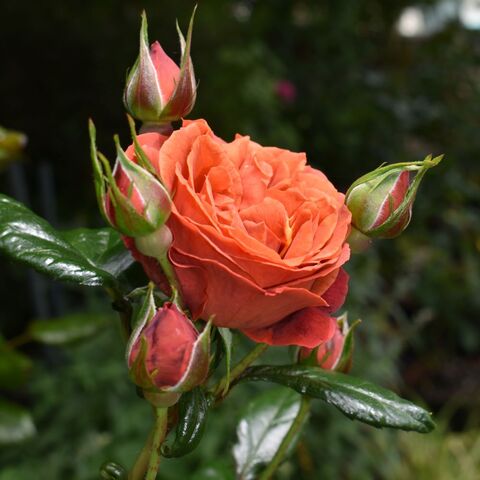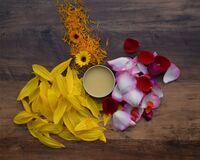The Perfect Time To Pick Petals
The Perfect Time to Pick Petals: A Guide for Harvesting, Drying and Pressing
There’s something deeply satisfying about gathering fresh petals from your own garden—especially when they’re destined for dried flower crafts, natural skincare, or pressed art. But timing is everything. Picking too early, you end up with small, unformed petals. Too late, and you risk browning, drooping, or less of an aroma.
So, when is the perfect time to pick petals? Let’s walk through the ideal harvesting times for popular blooms like rose, calendula, cornflower, sunflower and lavender. Whether you're drying them for potpourri, infusing them into oils, or preserving them in handmade paper, this guide will help you pick at the peak of beauty and benefit.

Rose Petals
Best Time to Pick: Early morning through to end of day, after the dew has dried. We harvest in the evening before watering as the petals have the least moisture content.
Stage: Half-open to fully open blooms (but not wilting). I feel the inner petals and wait until they have loosened up before picking the whole rose head. This is a bit tricky with the florabuna varieties as the petals form differently so I usually wait until these are fully open.
Rose petals are at their most fragrant and colorful just before they fully open or right as they bloom. Older petals may start to brown or lose vibrancy. Avoid picking immediately after rain or in full sun, as the heat and moisture can diminish scent and shelf life.
Tip for Drying: Once you have a collection of fresh heads gently hold upside down with all the petals in one hand and the stem in the other and crack the petals off, they should come off in one lot (once again the florabunda’s don’t do this). Lay the petals flat turning over every other day. You can use a dehydrator but they will shrink to a third of their size which is why I choose to air dry, there is still some petal shrinkage but nowhere near as much as other methods.
Calendula Petals
Best Time to Pick: Mid-morning, after the sun has dried any moisture and the flower heads have opened back up.
Stage: Fully open, fresh blooms.
Calendula’s sticky resin and vibrant yellow-orange petals make it a favorite for skincare. Harvest when the flowers are wide open and looking bright—this is when the resins and medicinal properties are most concentrated.
Tip for Drying: Some people dry the whole flower with the petals on and then depetal but I choose to take the petals off while they’re still fresh and lay out on trays to dry, I find I get a cleaner petal with no stamen bits attached.
Bonus: Calendula petals are edible too. Use fresh in salads, or dry for tea and salves.
Cornflower Petals
Best Time to Pick: Late morning or early afternoon.
Stage: Freshly opened blooms.
Cornflowers dry beautifully and retain their brilliant blues. Pick them just as they open for the best color. If you wait too long, they’ll fade and become brittle. Snip the petals or remove them from the heads before drying.
Tip for Drying: Depending on what you want to use them for as to how you dry them. I split mine into two groups, some I will depetal and dry on trays to use in skincare, potpourri and culinary and the some I will depetal and place straight in my flowerpress books to dry and preserve perfectly for use in arts and crafts.
Best Use: Cornflower petals are popular in confetti mixes, soaps, and resin art. Note: it takes a lot of flowers to get a decent amount of petals as they shrink considerably as they dry.
Sunflower Petals
Best Time to Pick: Late afternoon on a dry day.
Stage: When the petals are fully formed, the seed head may not be fully formed yet and you want to pick them but before the petals start drooping. You can test a petal to see if it will crack off the seed head at the base of the petal, if they don’t snap off leave another day or two otherwise the petal tears.
You might not have considered picking the sunflower petals off the head to dry separately, but let me tell you that they are beautiful, they are large, hold their colour and shape well and can be used in so many ways (they are even edible). We literally could not keep up with the demand when we’ve had them for sale.
Drying Note: Crack/snap them off the seedhead and dry in trays, they don’t seem to hold a nice form if they’re dried upside down on the head.
Lavender
Best Time to Pick: Early morning, before the sun is too strong.
Stage: Just before all the florets are fully open.
Harvest lavender when about half the buds on a stalk have opened. This is when the oils are at their peak and scent is strongest. If left too long, the flowers can become brittle and lose both scent and brown during drying.
Pro Tip: Use sharp scissors or garden snips and harvest on the stem so they are easy to dry by hanging. Once dried you can pull the petals off.
Other Petals to Consider:
Hydrangeas
If you’re wanting to dry the petals for pressed flowers, harvest when in peak bloom. If you’re wanting to use the flowerheads for dried bunches, harvest after they have started to change colour and get a vintage hue but before they start to brown off. Note: Hydrangea petals are non-edible.
Geranium Petals
Pick just as they open for the best shape and vibrant colors. Excellent for pressing.
Salvia flowers
Harvest individual salvia flowers when fully open. Vibrant reds, purples and blues hold color well when dried. They do bruise easily though so will need care when handling.
Forsythia
Harvest individual petals at peak bloom. While the petals fade in color slightly during drying, they still hold value for skincare and herbal uses.
General Tips for Petal Harvesting
- Time of Day: Morning is usually best—after the dew has evaporated but before the sun is too hot. This keeps the petals hydrated and fragrant.
- Weather Matters: Always harvest on a dry day. Moisture leads to mold in dried or pressed flowers.
- Avoid Overripe Flowers: Once petals begin to fade, curl, or drop, they’re past their prime for drying or skincare use.
- Use Clean Tools: Always use clean snips or scissors to avoid transferring bacteria to delicate petals.
- Handle Gently: Petals bruise easily—treat them like silk!
Drying & Storage Tips
Once you’ve picked your petals, dry them quickly to preserve color, scent, and shape.
- Air Drying Petals: Spread petals out in a single layer on a mesh screen or paper towel in a warm, dark, dry spot.
- Dehydrating Petals: Use a dehydrator on its lowest heat setting (ideally below 35°C / 95°F). Note that some petals will shrink considerably if drying this way.
- Pressing Petals: Place petals between two sheets of absorbent paper and flatten under a heavy book or use a flower press.
Store dried petals in airtight containers, glass jars, or paper bags out of direct sunlight. Properly dried and stored petals can last up to a year (or more), depending on the plant.
Final Thoughts
There’s a difference between a flower that’s been grown and harvested for drying and a flower that is old and drying for use is an afterthought. The perfect time to pick petals comes down to freshness, timing, and your purpose—whether it’s for making soothing calendula oil, fragrant rose bath salts, or vibrant cornflower confetti. By learning the ideal moment for each bloom, you’ll capture their color, essence, and beauty at its best.
So the next time you step into your garden, basket in hand, you’ll know exactly when to snip, pluck, and preserve nature’s treasures.
Posted: Wednesday 25 June 2025


